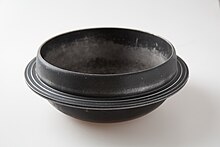Gamasot
| Korean spelling | |
|---|---|
| Korean alphabet : | 가마솥 |
| Revised Romanization : | Gamasot |
| McCune-Reischauer : | Kamasot |

Gamasot ( Korean : 가마솥 ) is a large, heavy Korean cooking vessel traditionally made of cast iron .
Origin of name
The term Gamasot ( 가마솥 ) is made up of the words gama ( 가마 ), which stands for oven or stove, and sot ( 솥 ), which denotes a kettle or saucepan. Put together, the word means large kettle or large saucepan.
Types of boilers
While gamasot refers to a certain size of cast iron kettles that were typically used in the kitchens of traditional Korean hanok houses for cooking rice or for cooking large amounts of soup, the smaller versions of the cast iron kettles Ongsot ( 옹솥 ) and Jungsot ( 중솥 ) and the size of kettles exceeding the Gamasot is called Dumeongsot ( 두멍 솥 ).
The largest gamasot ever created originated in Goesan-gun ( 괴산군 ), in the province of Chungcheongbuk-do ( 충청북도 ). Its builder, Kim Mun-bae ( 김문배 ), wanted to add an attraction to the place and in 2005 created a cauldron with a diameter of over 5.6 m, a circumference of 17.8 m and a height of 2.2 m. A total of 43.5 tons of iron was used for the boiler. Kim hoped to be included in the Guinness Book of Records , which unfortunately failed because there was already a bigger pot in Australia . The kettle cost around 500 million won at the time and an attempt to cook rice in it also failed.
history
The cast iron cauldrons were first used in the late period of the Three Kingdoms to cook rice in Korean cuisine. Because it made it easier to cook large quantities of rice and keep them warm, rice became the main ingredient in Korean cuisine. By the 1950s, every household in Korea had a number of Gamasot kettles that were used to cook rice or soup.
Manufacturing
In the traditional way of making gamasots, a stove is fired with wood and coal and air is blown into the embers to stoke the fire. Then coke and limestone are added and the pig iron is heated to 2100 ° C in the furnace. A constant temperature is a prerequisite for a successful casting process. Even small temperature fluctuations can reduce the quality of the cast iron kettle. After the refined iron has been poured into a mold, the mold must be cooled to at least 800 ° C before the iron kettle can be released from the mold, due to the risk of warping of the cast material.
The casting master Kim Jong-hun ( G ), who was born in 1930 and is well-known in South Korea , began his craft shortly after the end of the Korean War in 1953. The skills taken over from his father, Kim still pours and manages the melt using the old traditional casting method into the shape by hand. Anseong ( 안성 ), the seat of his family, has always been known for cast iron goods and articles made of brass and so Kim, whose son also casts his own creations in addition to the traditional Gamasot and combines traditional casting techniques with new design of his products, leads the Korean tradition of casting away.
Intangible cultural heritage
In 2003, Mr. Kim's Cast Iron Casting Craft was recognized as the best craft in the province by Mr. Kim in Gyeonggi-do ( 경기도 ) Province, and in 2006 it was named the Provincial Intangible Cultural Heritage with registration number 45 .
literature
- Koreana - Korean Cultural Heritage . Volume IV . The Korea Foundation , Seoul 1977, ISBN 89-86090-13-9 (English).
- Traditional Food: A Taste of Korean Life (= Korea Essentials . No. 4). The Korea Foundation , Seoul 2010, ISBN 978-1-62412-036-7 (English).
- Ahn Hong-beom: One hundred years, melted in Anseong's famous cast iron kassel . In: Koreana . Volume 13, No. 1. The Korea Foundation , 2018, ISSN 1975-0617 , p. 44–47 (German language edition).
- Minjungs Korean-German Dictionary . Korean Society for German Studies, Seoul 1981, ISBN 978-89-387-0502-0 (Korean).
Individual evidence
- ↑ a b Minjungs Korean-German Dictionary . 1981, p. 19 .
- ↑ Minjungs Korean-German Dictionary . 1981, p. 1067 .
- ↑ Traditional Food: A Taste of Korean Life . 2010, Kitchen Utensils .
- ↑ Lee Sung-eun : Wasting taxpayer money creatively . Korea JoongAng Daily , April 1, 2015, accessed November 3, 2018 .
- ^ Koreana - Korean Cultural Heritage . 1997, p. 173 .
- ↑ a b Ahn: One hundred years, melted down in Anseong's famous cast iron kassel . 2018, p. 45 .
- ↑ Ahn: One hundred years, melted in Anseong's famous cast iron coffin . 2018, p. 46 f .
- ↑ a b Ahn: One hundred years, melted down in Anseong's famous cast iron kassel . 2018, p. 47 .

